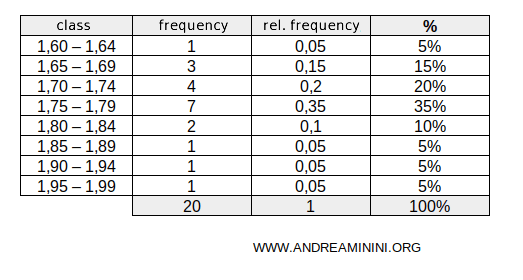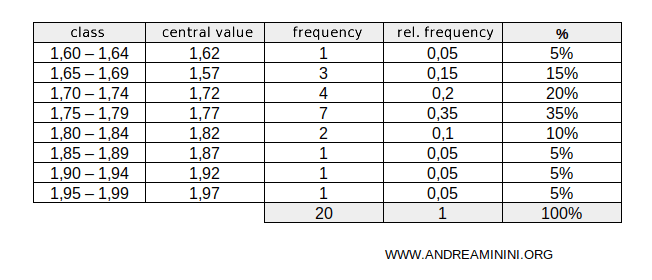Absolute and Relative Frequency in Statistics
What is frequency?
In statistics, frequency refers to how often a specific event or value occurs in a data set.
There are two main types of frequency:
- Absolute Frequency
Absolute frequency is simply the number of times a particular event or value appears in a data set.Example: If a data set consists of 50 people, and 30 of them are female, the absolute frequency of females is 30.
- Relative Frequency
Relative frequency is the proportion of times an event occurs in relation to the total number of observations. It's calculated by dividing the absolute frequency (F) by the total number of observations (T): $$ f = \frac{F}{T} $$ Relative frequency can be expressed as a decimal or a percentage.Example: In a data set of 50 people, with 30 being female, the relative frequency of females is 0.6 (or 60% when expressed as a percentage). $$ f = \frac{absolute freq.}{total} = \frac{30}{50} = 0.6 = 60% $$
The sum of all relative frequencies in a data set should equal 1 (or 100% when expressed as a percentage).
A Practical Example
Here’s a practical example.
In this frequency table, we show the gender breakdown of a class of students:
| Category | Absolute Frequency | Relative Frequency | % |
|---|---|---|---|
| Male | 8 | 0.4 | 40% |
| Female | 12 | 0.6 | 60% |
| Total | 20 | 1 | 100% |
The observed characteristic here is gender, which comes in two categories: male (M) and female (F).
The class consists of 20 students, which is the total number of observations.
Note: The total number of observations is often called the population, and each student is referred to as a statistical unit.
There are 8 males and 12 females in the class, which are the absolute frequencies for each gender.
If we divide the absolute frequencies by the total number, we get the relative frequencies:
$$ \frac{8}{20} = 0.4 $$
$$ \frac{12}{20} = 0.6 $$
Note: Relative frequencies can also be expressed as percentages. To convert a relative frequency to a percentage, multiply the decimal value by 100: $$ \frac{8}{20} = 0.4 \cdot 100 = 40% $$ $$ \frac{12}{20} = 0.6 \cdot 100 = 60% $$
The sum of all relative frequencies is 1 in decimal form or 100% when expressed as percentages.
| Category | Absolute Frequency | Relative Frequency | % |
|---|---|---|---|
| Male | 8 | 0.4 | 40% |
| Female | 12 | 0.6 | 60% |
| Total | 20 | 1 | 100% |
This is called a frequency table.
The set of ordered pairs, consisting of the category (M, F) and their corresponding frequency (8, 12), forms the frequency distribution.
$$ (M, 8) \\ (F, 12) $$
The Relationship Between Absolute and Relative Frequencies: Absolute and relative frequencies are closely connected. If you know one, you can easily calculate the other. $$ f = \frac{F}{T} $$ $$ F = f \cdot T $$ For example, if you know the relative frequency (f) of males in a class of 20 students (T), you can find the absolute frequency (F) by multiplying the relative frequency (f=0.4) by the total number of students (T=20). $$ F = f \cdot T = 0.4 \cdot 20 = 8 $$ If the relative frequency is expressed as a percentage, you can calculate it as follows: 40% = 40/100 = 0.4 $$ F = f \cdot T = 40\% \cdot 20 = \frac{40}{100} \cdot 20 = 0.4 \cdot 20 = 8 $$
Frequency Classes
When a characteristic has many different values, it can be useful to group them into frequency classes. Each frequency class groups several values together.
For example, let’s study the height of students in a class of 20 people.
The students’ heights vary, sometimes by just a few centimeters.
| Students | Height (m) |
|---|---|
| Alexander | 1.75 |
| Alice | 1.72 |
| Andrew | 1.79 |
| Beatrice | 1.70 |
| Claire | 1.71 |
| David | 1.76 |
| Eliza | 1.68 |
| Frederica | 1.82 |
| Frances | 1.65 |
| Grace | 1.77 |
| John | 1.79 |
| Julia | 1.74 |
| Irene | 1.67 |
| Luke | 1.85 |
| Mark | 1.91 |
| Martina | 1.81 |
| Matthew | 1.95 |
| Sara | 1.75 |
| Simon | 1.77 |
| Valerie | 1.64 |
In these situations, it's helpful to group the values into classes and measure the absolute and relative frequencies of each class.
We can create four classes by counting how many students fall into each frequency class.

This provides a more concise representation of the data.
Note: Grouping data into classes may result in some loss of detail, but it offers a clearer and easier-to-interpret summary of the data.
It's often useful to calculate the central value for each class.
This is done by finding the arithmetic mean of the class boundaries.

Example: For the first class, 1.60-1.64, the lower boundary is 1.60 and the upper boundary is 1.64. The arithmetic mean of these boundaries is 1.62: $$ \frac{1.60 + 1.64}{2} = 1.62 $$
